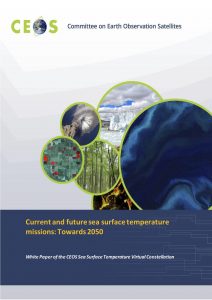The Sea Surface Temperature Virtual Constellation (SST-VC) serves as the formal link between the Group for High-Resolution Sea Surface Temperature (GHRSST) and the broader CEOS community. At the highest level, the SST-VC provides a means for CEOS to present its needs and requirements to GHRSST and for GHRSST to present its needs directly to CEOS, the global community of space agencies. In addition, there are several thematic connections between GHRSST and CEOS that take place at the working group level (e.g. between the GHRSST Climate Data Record Technical Advisory Group and the CEOS Working Group on Climate).
Next-Generation SST Constellation
We have completed an SST white paper summarising the next-generation SST constellation, including on-orbit assets, measurement methods, fiducial reference measurements, and data management systems.
Sea surface temperature (SST) is a key variable for understanding, monitoring and predicting interactions between the ocean and the atmosphere. Its influence covers a wide range of temporal (from seconds to multi-decadal) and spatial (from a few microns to ocean scale) resolutions. It has a direct or indirect impact on a wealth of application areas.
The provision of daily maps of SST is now a mature and sustained service. Activities are coordinated by the Group for High Resolution SST (GHRSST) and the Committee for Earth Observing Satellites (CEOS) SST Virtual Constellation (SST-VC). This white paper sets out a basis for optimising components of the SST-VC.
Key challenges related to provision of Fiducial Reference Measurements (FRM) and data management are highlighted. One urgent need, for sustained continuity of passive microwave SST determination using a 6.9 GHz channel in an operational (redundant) context, is identified.
The Current and future sea surface temperature missions: Towards 2050 report is available here.
Other Recent Achievements
In November, 2015, we helped organize an opportunity for satellite oceanography data users to meet with and provide feedback to the data providers: a three-day Satellite Oceanography User Workshop focused on satellite-derived products of key oceanographic variables. We worked with the CEOS Working Group on Capacity Building & Data Democracy (WGCapD) to capture the workshop presentations & discussions on video for future access by data users unable to attend the workshop. Learn more and access the videos.
A recent focus of the SST-VC has been to increase the visibility of the impact of the passive microwave satellite constellation on sea surface temperature applications and to communicate the importance of the continuity of the PMW capability for SST. This began with a presentation in June, 2016 at the CGMS-44 meeting on “Passive Microwave Constellation for Sea Surface Temperature“. Then, in September, 2016, the SST-VC followed with a presentation to the CEOS SIT Technical Workshop in Oxford on “The Importance of PMW Constellation for SST and Impacts“. In December, 2017, we contributed a presentation at the joint ECMWF/ESA workshop on using low-frequency, passive microwave measurements in research and operational applications, titled, “The Use and Impacts of Sea Surface Temperature from Passive Microwave Measurements”.
Take a look at the latest Sea Surface Temperature Constellation timeline diagrams.
As of June, 2019, 96 standardized GHRSST specified products can be found in the GHRSST LTSRF archive, consisting of 7.21 million CF/ACDD netCDF data files and 161 TB, spanning the period September, 1982 to May, 2019.
Contact Us
Please feel free to contact the SST-VC Co-Chairs for more information:
- Misako Kachi (JAXA)
- Christo Whittle (CSIR)
